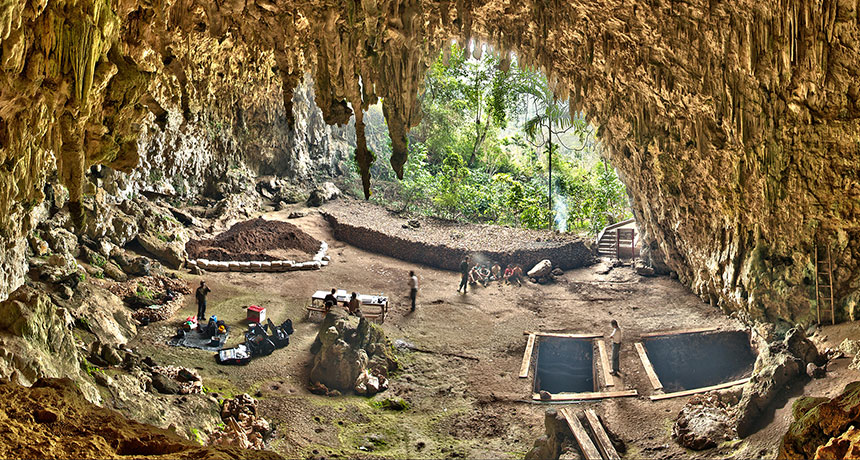Hobbits died out earlier than thought
Tiny hominids disappeared from their island about same time Homo sapiens appeared in the region

OLD HOBBITS New research at Liang Bua Cave on the Indonesian island of Flores suggests that controversial members of the human genus known as hobbits died out around 50,000 years ago, considerably before previous estimates.
Smithsonian Digitization Program Office, Liang Bua Team
Hobbits disappeared from their island home nearly 40,000 years earlier than previously thought, new evidence suggests.
This revised timeline doesn’t erase uncertainty about the evolutionary origins of these controversial Indonesian hominids. Nor will the new evidence resolve a dispute about whether hobbits represent a new species, Homo floresiensis, or were small-bodied Homo sapiens.
Hobbits vanished about 50,000 years ago at Liang Bua Cave on Flores, an island situated between Borneo and Australia’s northern coast, say archaeologist Thomas Sutikna of the University of Wollongong, Australia, and his colleagues.
Cave sediment dating to about 12,000 years ago, which lies just above soil that yielded H. floresiensis remains, provided an initial estimate of when these diminutive hominids died out. But that sediment washed into the cave long after H. floresiensis was gone, covering much older, hobbit-bearing soil, the researchers report online March 30 in Nature.
Using the initial age estimate, researchers had previously concluded that hobbits survived for tens of thousands of years after Homo sapiens passed through Indonesia and reached Australia around 50,000 years ago. It now appears that hobbits instead hit an evolutionary dead end around that time, Sutikna’s group says.
The centerpiece of hobbit finds, a partial skeleton, comes from an individual who lived well before then, the scientists add. Measurements of the decay of radioactive elements in an arm bone from the partial skeleton indicate that the find dates to between 86,900 and 71,500 years ago. Until now, researchers suspected these bones were only about 18,000 years old.

Based on the new dates, “there was possibly no overlap or interactions between H. floresiensis and H. sapiens on Flores,” says paleoanthropologist Richard Potts of the Smithsonian Institution in Washington, D.C.
Hobbits disappeared before the earliest skeletal evidence of humans on Flores, says paleoanthropologist and study coauthor Matthew Tocheri of Lakehead University in Thunder Bay, Canada. H. sapiens bones date to around 11,000 years ago on the Indonesian island. That undermines a controversial argument that a partial hobbit skeleton comes from a human with a developmental disorder (SN: 11/18/06, p. 330), Tocheri says.
Paleoanthropologist Russell Ciochon of the University of Iowa in Iowa City agrees. H. floresiensis probably descended from a large-bodied Asian Homo erectus group that reached Flores roughly 1 million years ago, he says. On islands, large-bodied mammals tend to become smaller, presumably in response to limited food sources and other factors.
But in a joint e-mail to Science News, two researchers who regard hobbits as humans — and the partial hobbit skeleton as displaying signs of Down syndrome — stick to their guns. Regardless of the new dates from Liang Bua Cave, hobbit bones fall within the range of skeletal sizes and shapes observed in people today, assert Robert Eckhardt of Penn State and Maciej Henneberg of the University of Adelaide in Australia. H. sapiens could have reached Flores and nearby islands (SN: 2/6/16, p. 7) when Sutikna’s group says hobbits were alive, they claim.
It’s not known whether humans or other Asian hominids, such as Denisovans (SN Online: 3/17/16), reached Flores more than 50,000 years ago at a time of lowered sea levels and possible drought on the island, Potts says. If they did, intruding species might have pushed an already reeling hobbit population to extinction.
Liang Bua Cave excavations also suggest that other Flores animals, including vultures, giant marabou storks and an extinct elephant relative, vanished around the same time that the hobbits did.
Annual excavations from 2007 through 2014 clarified how sediment accumulated in the cave. A thick soil deposit containing hobbit remains had substantially eroded before being covered by soil layers that washed into the cave starting around 20,000 years ago. Techniques for dating soil, rock, volcanic ash and bone indicated that hobbits’ skeletal remains ranged in age from 100,000 to 60,000 years ago. Stone tools probably made by hobbits dated to between around 190,000 and 50,000 years ago.
Liang Bua Cave preserves a late slice of H. floresiensis life on an island probably reached by toolmaking hobbit ancestors around 1 million years ago (SN: 6/3/06, p. 341), Tocheri says.
Researchers don’t know what happened during the roughly 800,000 years between hobbit ancestors’ arrival on Flores and hobbits’ last evolutionary stages. “If there was a book that chronicled the evolutionary history of H. floresiensis, we would have only a few tattered and torn pages with the rest missing,” Tocheri says.
Editor’s Note: This story was updated April 7, 2016, to correct the study’s publication date, and April 4, 2016, to clarify the description of hobbits and the scientific discipline of one of the researchers.







